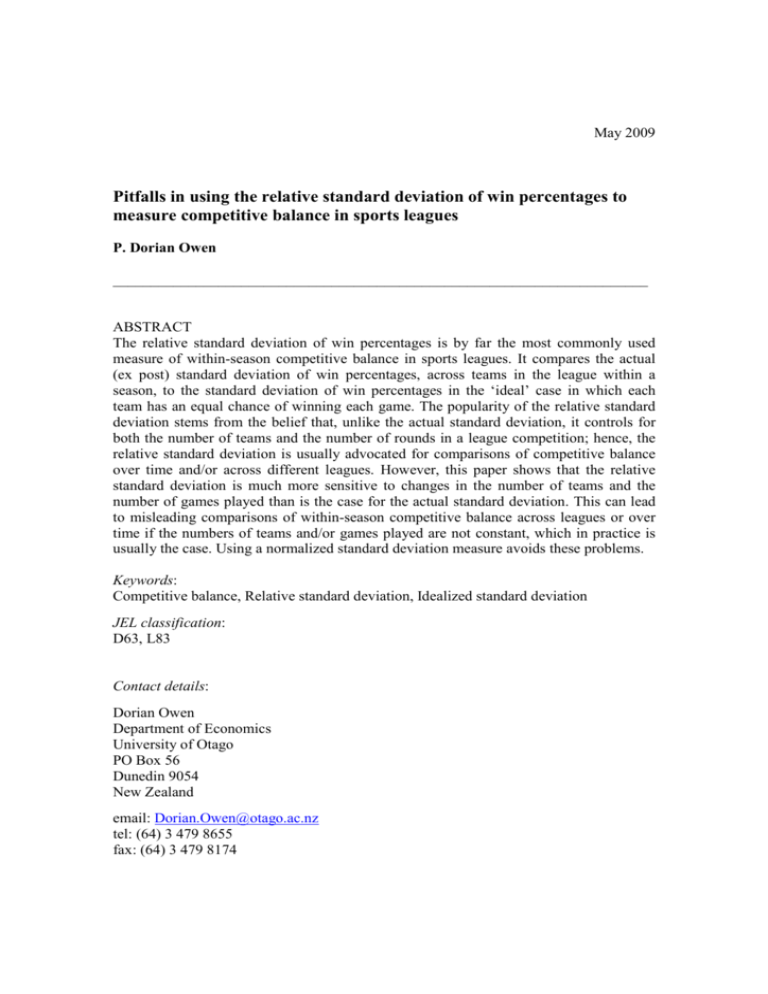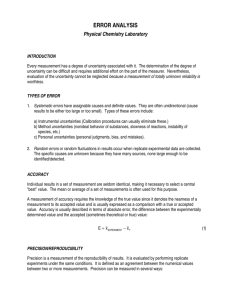
May 2009
Pitfalls in using the relative standard deviation of win percentages to
measure competitive balance in sports leagues
P. Dorian Owen
_______________________________________________________________________
ABSTRACT
The relative standard deviation of win percentages is by far the most commonly used
measure of within-season competitive balance in sports leagues. It compares the actual
(ex post) standard deviation of win percentages, across teams in the league within a
season, to the standard deviation of win percentages in the ‘ideal’ case in which each
team has an equal chance of winning each game. The popularity of the relative standard
deviation stems from the belief that, unlike the actual standard deviation, it controls for
both the number of teams and the number of rounds in a league competition; hence, the
relative standard deviation is usually advocated for comparisons of competitive balance
over time and/or across different leagues. However, this paper shows that the relative
standard deviation is much more sensitive to changes in the number of teams and the
number of games played than is the case for the actual standard deviation. This can lead
to misleading comparisons of within-season competitive balance across leagues or over
time if the numbers of teams and/or games played are not constant, which in practice is
usually the case. Using a normalized standard deviation measure avoids these problems.
Keywords:
Competitive balance, Relative standard deviation, Idealized standard deviation
JEL classification:
D63, L83
Contact details:
Dorian Owen
Department of Economics
University of Otago
PO Box 56
Dunedin 9054
New Zealand
email: Dorian.Owen@otago.ac.nz
tel: (64) 3 479 8655
fax: (64) 3 479 8174
1. Introduction
Competitive balance in sports leagues, i.e., how evenly teams are matched, is reflected
in the degree of inequality in match and championship outcomes. Because of its pivotal
role in the economic analysis of professional sport, considerable effort has gone into
measuring competitive balance. By far the most commonly used measure is the relative
standard deviation of win percentages. This compares the actual (ex post) standard
deviation of win percentages with the standard deviation of win percentages in the ‘ideal’
case in which each team has an equal chance of winning each game.
The relative standard deviation of win percentages is widely regarded as the most
useful measure of competitive balance “because it controls for both season length and the
number of teams, facilitating a comparison of competitive balance over time and between
leagues” (Fort, 2007, p. 643). This widely held view is misplaced. For comparable levels of
competitive balance, the relative standard deviation of win percentages is sensitive to
changes in the number of teams or games played. This can lead to misleading comparisons
of within-season competitive balance across leagues or over time if the numbers of teams
and/or games played are not constant, which in practice is usually the case. These problems
can be avoided by using a normalized standard deviation measure that takes into account
variations in the relevant upper bound.
2. Measuring competitive balance with actual and relative standard deviations
Competitive balance in a sports league is a multi-faceted concept. The different
dimensions include the distribution of wins across teams in the league within a single
1
season, the persistence of teams’ record of wins across successive seasons over time, and
the degree of concentration of overall championship wins reflected in teams’ shares of
championship wins over a number of seasons (Kringstad and Gerrard, 2007).
The ex post or ‘actual’ standard deviation (ASD) of teams’ win ratios (or, equivalently,
win percentages) in a single season is a natural measure for the first of these dimensions.
This can be represented as
ASD =
N
∑[(w / G ) − 0.5]
i
i
2
/N
(1)
i =1
in which N equals the number of teams in the league, and wi and Gi are, respectively, the
number of wins and the number of games played by team i in a season. A smaller standard
deviation of win ratios across teams in a season indicates a more equal competition.
However, when comparing values of ASD, either for the same league over time or across
different leagues, N and/or G are typically not constant. Other things equal, ASD tends to
decrease as G increases, so it is common to compare ASD to a benchmark ‘idealized
standard deviation’ corresponding to an ex ante representation of a perfectly balanced
league in which each team has an equal probability of winning each game.1 In the absence
of ties (draws), the idealized standard deviation, ISD = 0.5/G0.5 can be derived as the
standard deviation of a binomially distributed random variable with a (constant) probability
of success of 0.5 across independent trials (Fort and Quirk, 1995).2 As G increases, there is
likely to be less random noise in the final outcomes and, hence, the idealized standard
1
The use of a relative measure involving a benchmark standard deviation corresponding to an ex ante
perfectly balanced league is attributable to Noll (1988) and Scully (1989), but became popular following its
use by Quirk and Fort (1992) and Fort and Quirk (1995).
2
If ties are possible, ISD can be applied to absolute total points or the percentage of points, with amendments
to account for different possible points allocations for wins, ties and losses (e.g., Fort, 2007).
2
deviation will be smaller. The relative standard deviation, RSD is thus expressed as
ASD/ISD.
RSD is a ‘static’ measure based on the variation of (final) win ratios across teams in a
single season. Its evolution can be plotted over time, but it does not capture championship
concentration or persistence of performance of individual teams over successive seasons.
Given the multidimensional nature of competitive balance, it is generally considered
unrealistic to expect any single measure to reflect all of its different dimensions. This apart,
the RSD measure has met with widespread acceptance. It is the most widely used
competitive balance measure in the sports economics literature; e.g., see the list of
competitive balance measures used in studies of the big four North American professional
sports leagues cited in Fort (2006a, Table 10.1).
However, despite its resounding endorsement as “the tried and true” measure of withinseason competitive balance (Utt and Fort, 2002, p. 373), RSD has properties that can lead to
invalid conclusions in comparisons of competitive balance involving different numbers of
teams and/or games.
RSD has an upper bound, because teams can not win games in which they do not play.
The complications this causes for interpretation of the Gini coefficient and the HerfindahlHirschman index applied to wins are documented by Utt and Fort (2002) and Owen et al.
(2007) respectively, but this well-known feature of the distribution of wins in sports
leagues also has implications for RSD that have not been recognized.
Another distinctive feature of RSD is the different measures of ‘sample size’ that appear
in its numerator (N, the number of teams) and denominator (G, the number of games played
by each team). If each team plays the other teams more than once in a season, then N and G
3
usually differ markedly. These characteristics can invalidate exactly the sorts of
comparisons of competitive balance (involving scenarios with different N and/or G) for
which RSD is usually advocated (e.g., Fort, 2006b, pp. 175-177; Leeds and von Allmen,
2005, pp. 160-161).
3. The sensitivity of the relative standard deviation to N and K
The degree of sensitivity of RSD to variations in N and K can most easily be seen by
considering the ex post ‘most unequal distribution’ of win ratios (Fort and Quirk, 1997;
Horowitz, 1997; Utt and Fort, 2002). This involves one team wining all its games, the
second team wining all except its game(s) against the first team, and so on down to the last
team, which wins none of its games. For ease of exposition, consider balanced schedules of
games in which each team plays every other team the same number of times, K.3 Each team
plays Gi = G = K(N − 1) games. The upper bound for ASD, denoted ASDub, is given by:4
ASDub = [(N + 1)/{12(N − 1)}]0.5
(2)
Substituting G = K(N − 1) into the expression for ISD, and noting that the ex ante ISD
measure is unaffected by the actual outcome for ASD, gives:
RSD ub =
ASD ub [( N + 1) /{12( N − 1)}]0.5
=
= 2[K(N + 1)/12]0.5
0.5
ISD
0.5 /[ K ( N − 1)]
(3)
3
With unbalanced schedules, additional assumptions about specific teams’ performances are required to
specify the most-unequal distribution and, hence, the upper limit of the standard deviation of win ratios.
4
See the Appendix for a derivation. Eq. (2) can also be obtained by substituting the expression for the
corresponding upper bound of the Herfindahl-Hirschman index (HHI) applied to wins, derived in Owen et al.
(2007, Appendix, pp. 300-301), into Depken’s (1999) Eq. (6), which expresses the variance of wins in terms
of the HHI.
4
The upper bound of RSD in Eq. (3) depends not only on the number of teams in the league,
N, but also on the number of times they play against each other, K. This is due to the
dependence of ISD on G and hence K, in contrast to ASDub, which is invariant to K.
Increases in N and/or K lead to increases in RSDub. This is conventionally interpreted as
implying a decrease in competitive balance, even though, given we are considering the
upper bound of RSD, wins are initially perfectly unequally distributed and remain that way.
The upper bound of ASD in Eq. (2) also depends on N, with expansions in N leading to a
decrease in ASDub.5 However, RSDub is much more sensitive than ASDub to variations in N.
This is illustrated in Fig. 1, and is apparent from a comparison of Eqs (2) and (3). For large
N, the (N + 1) and (N – 1) terms approximately cancel out, so that, in the limit, ASDub tends
to (1/12)0.5 = 0.289.6 For smaller values of N, as in most sports leagues, the dependence on
N is not removed entirely, but is relatively modest, with, for example, ASDub varying from
0.327 for N = 8 to 0.298 for N = 30 (a decrease of approximately 8.8%). In contrast, RSDub
→ ∞ as N → ∞ and, for commonly observed values of N, the increase in RSDub is more
dramatic than for ASDub, varying (for K = 1) from 1.732 for N = 8 to 3.215 for N = 30 (an
increase of approximately 85.6%). Rather than purging ASD of its dependence on the
number of teams and the number of games played, RSD’s use of ISD as a benchmark
actually makes it more sensitive than ASD to variations in N (and G).
Variation in the upper bounds can be explicitly incorporated in a normalized measure of
competitive balance, such as
ASD* = ASD/ASDub
(4)
It is straightforward to show that ∂ASDub/∂N < 0 if N ≥ 2.
This asymptotic result is consistent with ASD corresponding more closely to a pure inequality measure, such
as IGE(2), a member of the family of generalized entropy measures of inequality (Bajo and Salas, 2002).
IGE(2) = CV2/2, where CV is the coefficient of variation. If the mean of the win ratios in a season equals 0.5,
variation in CV applied to win ratios corresponds to variation in ASD.
5
6
5
The normalized measure, ASD*, lies in the interval [0, 1], with 0 representing perfect parity
and 1 maximum imbalance.7 This measure is also suggested by Goossens (2006), although
she calculates ASDub numerically for different values of N rather than deriving a general
expression. Goossens’s argument for preferring a normalized ASD measure to RSD is that
RSD can be less than 1 (if ASD < ISD). This is not surprising given the ex ante probabilistic
nature of ISD, in comparison to the ex post minimum (0) and maximum (ASDub) values for
ASD. However, the problems emphasized above, which make RSD unsuitable for
comparisons involving different N and K values, provide a more fundamental justification
for the use of a normalized standard deviation measure.
Problems with RSD are easiest to demonstrate in cases in which N or K is varied and
the degree of imbalance is controlled, as in the case of the upper bounds. Anomalous
results are, however, not confined to the case of perfect inequality. For example, consider
increasing K while maintaining the original level of competitive balance by ‘scaling up’,
i.e., reproducing exactly the corresponding set of results for the original league. As a
concrete example, consider a league with balanced schedules (N = 16, K = 2, G = 30) in
which ASD, is 0.037 and RSD is 0.408.8 If K is increased to 4 (e.g., each team playing
every other team twice at home and twice away) and assuming the additional home and
away results are identical to those in the actual two rounds played, then, clearly, this scaled
up set of results will display unchanged win ratios (and the same value for ASD), reflecting
an unchanged competitive balance situation. However, RSD increases to 0.577 (due to the
decrease in ISD). Increasing K to 10 and again reproducing the original results five times,
7
Trivially, the corresponding measure for RSD, i.e., RSD* = RSD/RSDub = ASD*, so this adjustment also
removes the dependence of the upper bound of RSD on K.
8
These results apply to what is widely believed to be one of the most competitive league outcomes in
association football: the 1983-84 season in the somewhat obscure Romanian Divizia C, Seria a VIII-a league
(see http://www.rsssf.com/miscellaneous/even.html).
6
leaves win ratios and ASD unchanged but RSD increases to 0.913, despite no change in
competitive balance. However, because the upper bound for RSD increases as K increases
(as in Eq. (3)), the normalized measure, RSD* (= ASD*) remains unchanged.
If N varies across time for a given league, similar anomalies can occur. For example, in
the First Division of New Zealand Rugby Union’s National Provincial Championship
(NPC) K =1 in round-robin play (prior to the semi-finals) but N has varied over time. The
RSD of win ratios (with draws, which are relatively rare in rugby, counting as 0.5 of a win)
was 1.763 in 1990 compared to 1.633 in 1994, suggesting a higher level of competitive
imbalance in 1990. However, the upper bounds for RSD were, respectively, 2.000 (N = 11)
and 1.826 (N = 9); RSD was therefore closer to the upper bound reflecting complete
inequality in 1994 (ASD* = 0.894) than in 1990 (ASD* = 0.882).
Even more misleading results can occur if RSD is used to compare competitive balance
across different leagues, because the differences in N and K are often considerably greater
than for a single league over time. Because of the sensitivity of RSDub to K and N, it is
feasible for the observed values of RSD in one league (with 0 < RSD < RSDub) to be greater
than the feasible value of RSDub in another. Interpreted literally this suggests that a less
than completely unbalanced league (with larger K and/or N) is more unbalanced than a
completely unbalanced league, which makes little sense. For example, the upper bound for
RSD for the NPC noted above (1.825 to 2) is less than many of the calculated RSD values
for the ‘big four’ US leagues reported in Fort’s (2006b) Table 6.3, especially basketball for
which all reported values are greater than 2 and many are greater than 3. For this sort of
comparison, the normalized measure, ASD*, is more appropriate.
7
4. Conclusion
In the sports economics literature there is a widespread belief that the idealized standard
deviation provides a ‘common standard’ (Leeds and von Allmen, 2005, p. 160) against
which to compare the actual standard deviation of win ratios. However, the resulting
relative standard deviation measure has an upper bound and hence a range of feasible
values which vary markedly in response to variation in the number of teams and/or
number of games played. This can lead to anomalous results and misleading conclusions
when comparing competitive balance across leagues or over time (involving scenarios
with different N and/or G), i.e., exactly the sorts of comparisons of competitive balance
for which RSD is advocated. The sensitivity of RSD to the number of teams and games
provides a much more compelling reason than previously advanced for using a
normalized standard deviation measure, rather than RSD, to measure within-season
competitive balance.
8
Appendix: Derivation of upper bounds for ASD and RSD
The upper bounds of ASD and RSD applied to win ratios are derived on the assumption of a
perfectly unbalanced league of teams playing a balanced schedule with no ties (draws) or
with ties (draws) treated as half a win. In a balanced schedule, in which each of the N teams
plays every other team the same number of times, K, each team plays G = K(N − 1) games.
The actual (ex post) variance of win ratios (AVAR) across the N teams in a season (with the
mean win ratio equal to 0.5 for any degree of competitive balance) is given by:
N
N
i =1
i =1
AVAR = [∑ ( wi / Gi ) 2 / N ] − (0.5) 2 = [∑ ( wi / K ( N − 1)) 2 / N ] − (0.5) 2
In a perfectly unbalanced league
AVARub =
1
N
K 2 ( N − 1) 2 K 2 ( N − 2) 2
K 2 (N − N )2
+
+
...
+
− (0.5) 2
2
2
2
2
2
2
K
(
N
−
1
)
K
(
N
−
1
)
K
(
N
−
1
)
Note that the K2 terms cancel, implying that AVARub and hence ASDub are invariant to the
number of rounds played if schedules are balanced. Simplifying,
AVARub =
1
[( N − 1) 2 + ( N − 2) 2 + ... + ( N − N ) 2 ] − (0.5) 2
2
N ( N − 1)
=
1
N (2 N − 1)( N − 1)
2
2
− (0.5)
N ( N − 1)
6
=
(2 N − 1) 1
N +1
− =
6( N − 1) 4 12( N − 1)
(Owen et al., 2007, p.301)
Taking the square root, ASDub = (AVARub)0.5 gives the result in Eq. (2).
ISD = 0.5/[K(N − 1)]0.5 does not depend on the actual outcome for ASD; hence
RSDub = ASDub/ISD
giving the result in Eq. (3).
9
References
Bajo, O., Salas, R., 2002. Inequality foundations of concentration measures: An application
to the Hannah-Kay indices. Spanish Economic Review 4, 311-316.
Depken, C.A. II, 1999. Free-agency and the competitiveness of Major League Baseball.
Review of Industrial Organization 14, 205-217.
Fort, R., 2006a. Competitive balance in North American professional sports. In: Fizel, J.
(Ed.), Handbook of Sports Economics Research (M.E. Sharpe, Armonk, NY), pp. 190206.
Fort, R.D., 2006b. Sports Economics (Second edition) (Pearson Prentice Hall: Upper Saddle
River, NJ).
Fort, R., 2007. Comments on “measuring parity”. Journal of Sports Economics 8, 642-651.
Fort, R., Quirk, J., 1995. Cross-subsidization, incentives, and outcomes in professional team
sports leagues. Journal of Economic Literature 33, 1265-1299.
Fort, R., Quirk, J., 1997. Introducing a competitive economic environment into professional
sports. In: Hendricks, W. (Ed.), Advances in the Economics of Sports, Volume 2 (JAI
Press, Greenwich, CT), pp. 3-26.
Goossens, K., 2006. Competitive balance in European football: comparison by adapting
measures: national measure of seasonal imbalance and top3. Rivista di Diritto ed
Economia dello Sport 2, 77-122.
Horowitz, I., 1997. The increasing competitive balance in Major League Baseball. Review of
Industrial Organization 12, 373-387.
Kringstad, M., Gerrard, B., 2007. Beyond competitive balance. In: Parent, M.M., Slack, T.
(Eds), International Perspectives on the Management of Sport (Butterworth-Heinemann,
Burlington, MA), pp. 149-172.
10
Leeds, M., von Allmen, P., 2005. The Economics of Sport (Second edition). (Pearson
Addison Wesley: Boston, MA).
Noll, R.G., 1988. Professional Basketball, Studies in Industrial Economics Paper No. 144.
Stanford University, Stanford, CA.
Owen, P.D., Ryan, M., Weatherston, C.R., 2007. Measuring competitive balance in
professional sports using the Herfindahl-Hirschman index. Review of Industrial
Organization 31, 289-302.
Quirk, J., Fort, R.D., 1992. Pay Dirt: The Business of Professional Team Sports. (Princeton
University Press, Princeton, NJ).
Scully, G.W., 1989. The Business of Major League Baseball. (University of Chicago Press,
Chicago, IL).
Utt, J., Fort, R., 2002. Pitfalls to measuring competitive balance with Gini coefficients. Journal
of Sports Economics 3, 367-373.
11
12.0
Upper bounds of RSD , ASD
10.0
RSD ub (K = 10)
8.0
RSD ub (K = 5)
6.0
RSD ub (K = 2)
4.0
RSD ub (K = 1)
2.0
ASD ub
0.0
8
13
18
23
28
Number of teams (N )
Fig.1. Variation in the upper bounds of RSD and ASD with N and K
12









